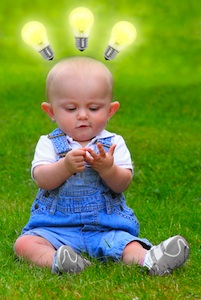“You can’t separate intellect and feelings in the work of the mind. They’re both there all the time. Real learning—attentive real learning, deep learning—is playful and frustrating and joyful and discouraging and exciting and sociable and private all at the same time, which is what makes it great.” ~ Eleanor Duckworth
Know when to memorize. Know when to mesmerize!
If we want students to learn deeply and efficiently we need to understand the role emotions play in different types of learning. We could spend much time discussing what it means to learn. In fact, Seymour Sarason has a whole book called “And What Do You Mean by Learning?”
Without getting into it too deeply, we could probably agree that we want students to acquire some knowledge, skills and attitudes. So how should kids ‘get that knowledge’? A constructivist approach would suggest that kids need to assimilate information into existing schema or indeed construct new schema to accommodate new information and ideas. Lev Vygotsky might add that this happens best in a social setting.
Should Students Memorize Content?
 Other approaches would involve getting students to memorize content or procedural knowledge. While I believe there are times when this is quite appropriate, rote memorization continues to be an overused strategy that is often implemented without a deep understanding of its nuances. It becomes “memorization of decontextualized facts” rather than “active construction of new schema.”
Other approaches would involve getting students to memorize content or procedural knowledge. While I believe there are times when this is quite appropriate, rote memorization continues to be an overused strategy that is often implemented without a deep understanding of its nuances. It becomes “memorization of decontextualized facts” rather than “active construction of new schema.”
These days, there is a very vocal anti-memorization movement! We hear about collaboration, project-based learning, student agency, constructionism, and passion. All of which I support. I’ve been a fan of passion-based learning since I started teaching in 1970. Somehow it just seemed a matter of ethics and the culture of the day. Kids should love learning and love school. It was after all, the “love, peace and happiness” era.
Passion Constitutes More than Engagement
Passion-based learning has gained more ground recently. Why? Apart from the anti-memorization sentiments, the main rationale seems to be focused on engagement and motivation. Students are more likely to learn if they are captivated, motivated and engaged with the curriculum or projects in hand. We could unpack types and levels of engagement, but I’m sure we’d all agree on this: if the child is deeply engaged in a task there is greater likelihood that she will attend to it better and build requisite understandings and new schema that serve to increase the base of content and process knowledge desired.
But passion isn’t just about the motivational aspect. It’s deeper than engagement.
There are cognitive processes in the brain that are “turned on” by emotion – be that passion, anger, anxiety or other emotions.
 Emotions Impact Cognition
Emotions Impact Cognition
Here’s a sampling of thoughts from some great voices:
Eleanor Duckworth suggests that “…you can’t separate intellect and feelings in the work of the mind. They’re both there all the time. Real learning—attentive real learning, deep learning—is playful and frustrating and joyful and discouraging and exciting and sociable and private all at the same time, which is what makes it great” (in Teaching by Heart: The Foxfire Interviews, Sara Day Hatton, 2005, p. 21).
Paulo Freire, the great Brazilian educator, often suggested that we must teach with both our hearts and our minds, while Lev Vygotsky recognized the limitations of trying to explain ‘superior thinking processes’ without addressing the effects of emotion.
Nellie J. Zambrana-Ortiz in Pedagogy in (E)Motion suggests that “emotions color our ideas, move the reason, and stretch cognition.” She says, “Emotions are related to body as well as mind. There is no cognition without emotions, or emotions outside the limits of a cognitive experience, and progressive explanations of human learning and development must take into consideration the fusion of both.”
It’s real now that “science” says so
Why is it not a widely accepted fact that emotions impact cognition and why is it not central to our educational systems? My guess is that all the psychologists, philosophers and educators who have spoken about the centrality of emotions in learning haven’t been considered ‘real scientists’ by our western societies. We tend to like ‘hard’ science.
Well, now we are getting some ‘hard science’ as a result of breakthroughs in neuroscience research.
Antonio Damasio, a great neuroscientist, has researched this phenomenon extensively in recent years and has discovered that emotions are absolutely necessary in the decision-making process. He describes them as the “engine of the limbic system” – our “emotional brain.”
Priscilla Vail in her article “The Role of Emotions in Learning,” says ‘Emotion is an on/off switch for learning…the emotional brain, the limbic system, has the power to open or close access to learning, memory, and the ability to make connections.’
When students are passionately engaged in their learning – when they are mesmerized by their learning environment or activities – there are myriad responses in their brains making connections and building schema that simply would not occur without that passion or emotion.
 Much of what we ask kids to “memorize” has little emotional charge to it. Emotions can significantly alter the creation and recall of memories. People are better at remembering information that is emotionally charged – rather than information that is neutral or flat.
Much of what we ask kids to “memorize” has little emotional charge to it. Emotions can significantly alter the creation and recall of memories. People are better at remembering information that is emotionally charged – rather than information that is neutral or flat.
So when you are designing learning environments, remember that mesmerization trumps memorization!
Peter Skillen
Latest posts by Peter Skillen (see all)
- Project Based Learning (PBL): Am I Doing it Right? - February 14, 2019
- The Science of Passion Based Learning - April 9, 2013
- Scaffolding for Deep Understanding - November 30, 2012


Peter,
Great post. I believe so strongly in the impact of emotions on learning. Your article gets right to the point. Learners who are mesmerised are truly learning! Thanks so much.
Thank you Karen! Glad we are on the same wavelength! 🙂
I’m wondering if you could share with me some of your beliefs and perhaps some of the things you do in your practice to ensure that learners are passionate or emotionally connected? I’d love to learn more.
Thx
Peter
Very interesting post.
On a personal experience with emotions and learning please read wp.me/p1Bvm3-cN
You say, ” …learning will not be effective if it is not learned in a positive environment”. I agree – for the most part. 🙂
The interesting part is that, as you likely know from your studies, the valence of the emotion – positive or negative – affects the remembering of something. So, for some things, you will remember it better if it has either a negative or positive emotion attached to it rather than if it were totally emotionless!
These issues are rarely simple, right? So now that complexity needs to be unraveled in the context of a school environment!
Thoughts?
A good post that makes the reader think. However, there is little said about how to acquire a balance between ‘memorise’ and ‘mesmerise’.
Learning as a term is so broad that care has also to be taken about how it is addressed for it to have any use. A virtuoso musician cannot reach that level of musicianship with ‘mesmerise’ alone. Without the content – the ‘memorise’ – all that is left is simply acting out a part. Despite their complexity, balance between the ‘mesmerise’ and the ‘memorise’ and how these two can be intertwined is more important, not one used to the exclusion of the other.
Ken, you are absolutely right! 🙂
“there is little said about how to acquire a balance between ‘memorise’ and ‘mesmerise’.”
I basically invited people to think about when to use ‘memorisation’ and when to use ‘mesmerisation’ – but didn’t want to get into the intricacies and nuances of it all in this post. (Perhaps it was unfair of me to lead with ‘Know when to memorize. Know when to mesmerize!’ )
The main point I wanted people to think about was the notion that passion isn’t just about ‘engagement’ – that it has quite an impact on other aspects of the brain that result in the building of new schema.
But, as I said, I agree with you about the need for balance between memorisation and mesmerisation. 🙂 Maybe we should write another post about that together!
regards,
Peter
Thank you from Italy for the extremely interesting and useful bibliography about emotions and learning!
I am carrying out methodical observation on how emotions impact my students’ learning processes and I am reaching the conclusion that today’s teenagers really learn (or only learn!) when you appeal to their emotions.
Great post! 🙂
Miriam,
Thank you so much for the kind comments. I am fascinated by your project on “methodical observation on how emotions impact my students’ learning processes”. Would you please share more of your work with me? Or even with us all here?
Sincerely,
Peter
Peter,
Thanks for your reply. I’ll try and share something about my job with you, hoping not to get tangled in words! 🙂
I teach English as a second language to Italian High School students in Italy, and I have recently got them involved in projects with classes of peers from New Jersey, California and Australia. While, on the one hand, I apply traditional evaluation grids to their language performances, it’s also necessary for me to assess the efficacy of this project-based methodology and the impact it has on their learning. Observation and self-observation allow me to understand a lot about the way in which positive emotional involvement in school activities impacts and speeds up the students’ learning, making it permanent. The emotions that they feel during a video chat with their epals, or the empathy created by working at distance on the same document (be it a short story, or the Universal Declaration of Human Rights), make them enthusiastic, passionate and motivated learners. It is only through methodical observation that one can assess the impact of emotions and feelings on learning, and the high significance they have in life-long learning processes.
It was after a course for teacher trainers in Norwich, UK, that I became fully aware of the relevance of observation and self-observation in the teaching/learning process. Since then, I have adopted the strategies I had been taught during that course as part of my normal routine work, both as a teacher and teacher trainer. And, after all, observation and self-observation strategies are the only means we have to be able to evaluate how emotions impact on learning.
Sincerely,
Miriam
You say, “The emotions that they feel during a video chat with their epals, or the empathy created by working at distance on the same document (be it a short story, or the Universal Declaration of Human Rights), make them enthusiastic, passionate and motivated learners.” I love this. I also am glad you shared your learnings about ‘observation and self-observation’.
Thank you so much,
Peter
Thanks a lot for sharing an informative piece of article with us. I will go with the fact that passion contributes more than engagement. Great post Peter.
Thx Olive!
Here is a more comprehensive (and somewhat more technical) model of the interplay of emotions and learning:
“Cognition, Affect, and Learning”
https://sites.google.com/site/barrykort/home/cognition-affect-and-learning
Thank you for this comprehensive resource!